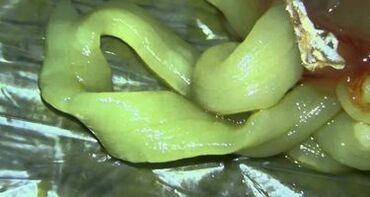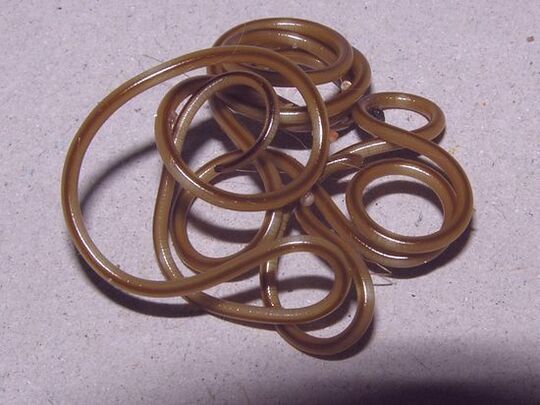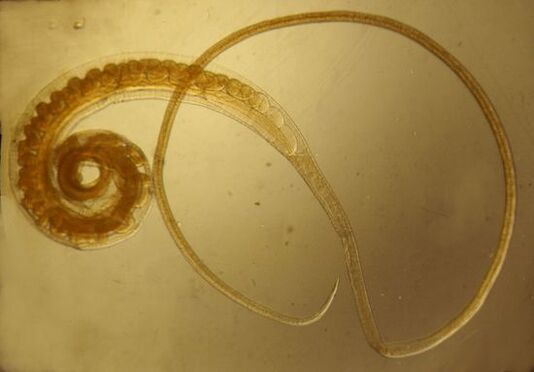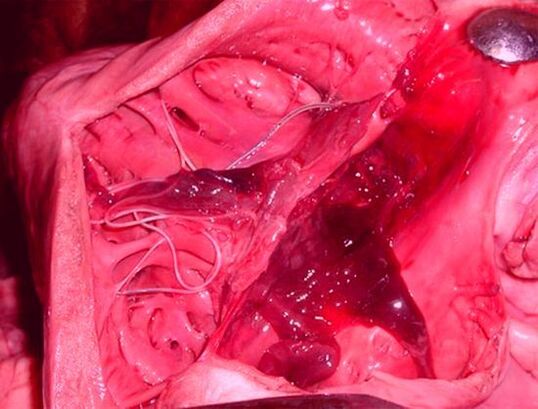
It is healthy to live in the world - parasites in the body interfere with this. These are lower forms of plants and animals that live at the expense of their owners. Translated from Greek, they mean - parasites.
In a parasitic way, they can be external and internal.
Parasites living in the human body are divided into flatworms and roundworms.
The flat ones are divided into flukes and cysts, respectively.
Roundworms are also known as roundworms.
Nematodes live in the human body

What types of parasites live in the body, first of all roundworms - they reach great lengths and have the shape of an earthworm, hence the name - roundworms, that is:
- roundworm;
- pinworm;
- hookworms;
- trichinella.
Roundworm
One of the most common roundworm species is a parasite, which in some cases can reach a size of 45 cm. Females lay 200, 000 eggs and this process occurs regardless of the presence of males in the host body. Along with feces, eggs fall to the ground, when they meet favorable factors, they will turn into larvae. You can get this worm through dirty hands and unwashed fruits and vegetables.
Signs of infection: nausea, salivation, loss of appetite. When there is a large number of roundworms, serious consequences can occur, rupture of sutures after surgery, the appearance of pancreatitis. Roundworms are especially dangerous for pregnant women - their ability to penetrate the fetus.
Pinworm
The small worms, up to 10 mm in size, are mainly infected by children, usually in kindergartens. The sick person becomes the cause of infection, and if the rules of personal hygiene are not observed, the likelihood of infection increases significantly. Signs of the appearance of worms:
- itching of the anal area at night;
- reduced performance;
- sleep disorders;
- neurological disorder.
The presence of pinworms, although not life-threatening, is quite uncomfortable and causes dysbacteriosis.
Hookworms
The 20mm parasite is pink, has little expression, but its harmful effects are great. His oral cavity has teeth and disks with which he gnaws blood vessels. The larvae enter the body through the skin of barefoot people.
The main task of the larvae is to enter the human mouth, from where when swallowing saliva, they enter the intestine, where adult worms are excreted. They feed on human blood, leading to anemia. The threat is posed by their waste products, which poison the body. Signs of the presence of helminths are: persistent bronchitis, dermatitis, nausea, abdominal pain, digestive disorders. The heart is infected with this parasite - myocarditis may appear.
Trichinella
The female of the worm is up to 4 mm long, the male is smaller. They die in the external environment and survive only inside the body. The source of infection is undercooked animal meat. Through the blood vessels, the parasites are distributed throughout the organs, take root and can live peacefully for 20 years.

The most common signs of infection are:
- an increase in blood tests of eosinophils;
- increase the temperature to 40 ° C;
- muscle pain;
- conjunctivitis and facial swelling.
Fluke parasites
The helminths are small in size, with a flat body, with two suction cups on top. Most of them are hermaphrodites. An intermediate server is required for development.
Fluke
Helminths - hermaphroditic species, growing up to 14 mm, affecting the biliary tract. After entering the water body, the eggs settle into the molluscs, where they develop into larvae, then the larvae settle on fish scales. If during this time a person eats poorly fried fish, then he or she may be infected with this parasite.
In its final host, a human, the fluke is introduced into the duodenum, where the larvae develop into adult helminths. Water bodies infested with fluke by people who eat fish products and work on geysers (their waste seeps into the water).
Schistosomes
Helminths, which have heterozygous individuals, are needle-like in their appearance. A pair of parasites produces up to 3000 eggs in 24 hours. A person becomes infected while bathing or with contaminated water. In the lungs and blood vessels, larvae become adults. After that, egg laying takes place in the intestines.
In the presence of schistosomes, the following are observed:
- stomachache;
- violation of appetite;
- anemia;
- transition from diarrhea to constipation;
- weight loss;
- violation of the cycle in women;
- impotence in men;
- decrease in academic achievement in children.
When inserted into nerve fibers, the development of paralysis, brain damage is possible.
Where can worms settle?
Often people are interested in where parasites live in the human body?
Localization is due to the type of host that has entered the body of the "parasite". Often they are deposited in the digestive organs, in the lungs, heart, liver.
The human body, where parasites live, becomes weakened and begins to suffer from various diseases, so how to identify parasites living in the body is not difficult at all. You just need to pay more attention to yourself, and if the slightest doubts arise, you can not delay going to the doctor.

In order for the living body of the 6-letter parasite to heal and become healthy, the sick person must follow the rules of hygiene, do not drink raw water and do not eat undercooked meat. Only then can the risk of infection be reduced.
It's great to live in this world and you don't want to think about parasites in the human body, but you have to. After all, every second person on Earth is infected with worms. The body in which the parasite lives is a realm of miracles, this will happen. But trusting in fate is the weak.





























